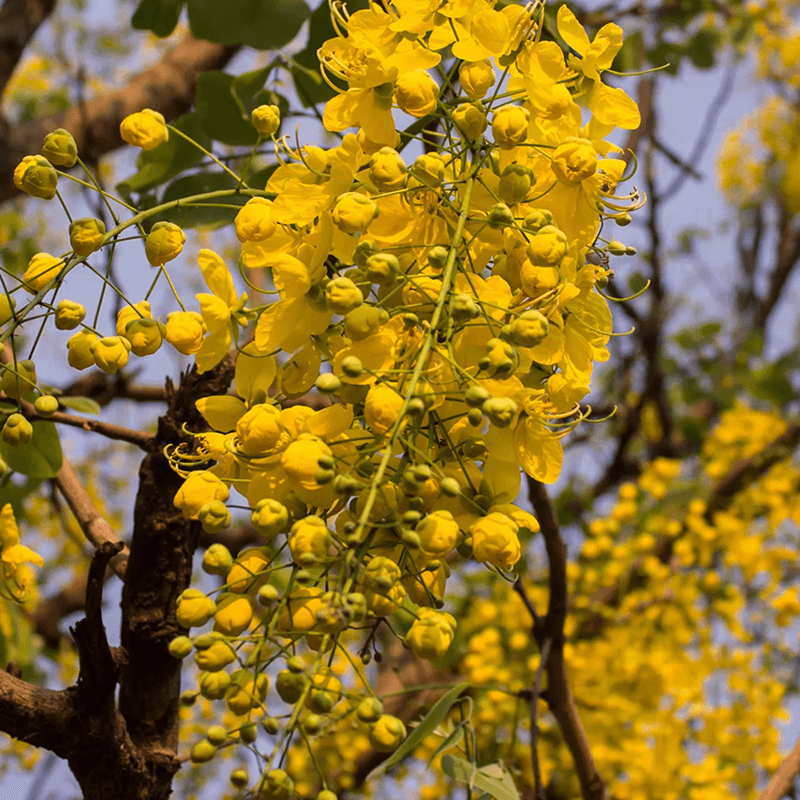Amaltas tree is a golden shower medium sized tree. Its growth is fastest up to 10-20 meter high. Amaltas Leaves are deciduous, long and pinnate. Three to eight leaves are combined to form a cluster and each leaflet is about 7-21 cm long and 5-9 cm broad. This tree produce pendulous racemes long flowers with five yellow equal sized petals. Amaltas Fruit is a legume with pungent smell serving several seeds inside. Amaltas Wood is very stable and durable.
Every part of Amaltas plant contains various phytochemicals.
- Amaltas Leaves – tannins, rhein, glucoside and sennosides.
- Amaltas Stem bark – fistucacidin, tannins, rhein and barbaloin.
- Amaltas Pulp – carbohydrates, proteins, leucin, tryptophan and glutamic acid.
- Amaltas Seeds – vermolic, sterculic and galactomannan
HABITAT
Amlatas is species easily found in Indian subcontinent and associated regions of south East Asia. It is also found in Pakistan, Myanmar, Thailand and Sri Lanka. In India it is easily available in Tamil Nadu and Kerala. It is famous ornamental and medicinal plant mentioned in Ayurveda from ancient times.
CLASSIFICATION
AMALTAS NAMES
- English name – Purging cassia
- Hindi name – Amaltas
- Sanskrit name – Aragvadha, Chaturangula, Rajvraksha, Shampaka, Suvarnaka, Deerghafala, Swarnabhushan
- Bengali name – Sondal
- Marathi Name –Bahva
- Punjabi name – Girdanali
- Arabic name – Kattan
- Gujarati name – Garmalo
- Telugu name – Rela
- Tamil Name – Kondrem
- Farsi name – Khiyar
AYURVEDIC PROPERTIES OF AMALTAS
|
Hindi / Sanskrit
|
English
|
|
Rasa
|
Madhur
|
Taste
|
Sweet
|
|
Guna
|
Mridu, Guru, Singdha
|
Physical Property
|
Soft, Heavy, Unctuous
|
|
Virya
|
Sheet
|
Potency
|
Cold
|
|
Vipaka
|
Madhur
|
Metabolic Property (After Digestion)
|
Sweet
|
AMALTAS EFFECTS ON DOSHA
It balances kapha and pitta dosha.
PRACTICAL USES OF AMALTAS (CASSIA FISTULA)
- According to Ayurveda, keeping the bowel clear is first step for the maintenance of a healthy body. When the gut is clear, the digestive fire can be maintained in a healthy way and the body can stay disease free for a long time.
- Care should be taken that the dosage may not exceed the stipulated amount as it may lead to diarrhea and cause a lot of discomfort.
- It is a great herbal remedy for constipation associated with Pitta imbalance.
- Amaltas also helps to vitiate all three body energies that is Vata, Pitta and Kapha body energy.
- Problems of indigestion like flatulence, belching, loss of appetite, feeling of fullness etc. can be regulated with its use.
- It is also good for cardiac problems like heartburn.
- The herb is used in bloating and severe abdominal pain.
- "Ama" is a common term given to undigested food particles which ferment in the body and release free radicals that damages cells. Herbal oil prepared from Amaltas is used to manage skin problems like eczema, candidiasis and similar skin conditions.
- Aragvadha can be given in all liver and gall bladder conditions. Even in Ascites, it can be used effectively to control abdominal distension and digestive problems associated with it.
- Because of its neutralizing action on the body energies, Aragvadha helps to keep all doshas and dhatus in balance. The herb manages blood disorders, gout, anemia and erysipelas etc problems.
- It is anti-pyretic and best used in bleeding disorders.
DOSAGE
- Fruit pulp – 5-10gm
- For purgation – 10-20gm
- Root bark decoction – 50-100ml
- Flowers – 5-10gm
CAUTION
It is not indicated in diarrhea and dysentery.
Large dose may cause heavy purgation.



